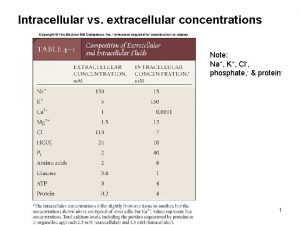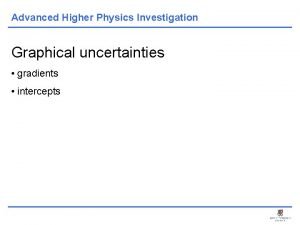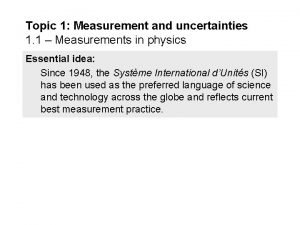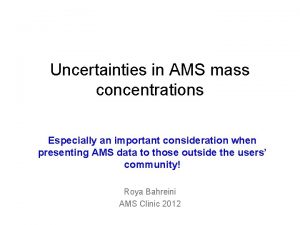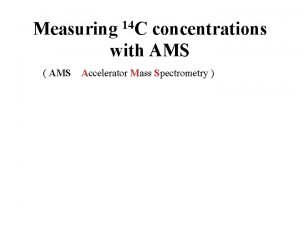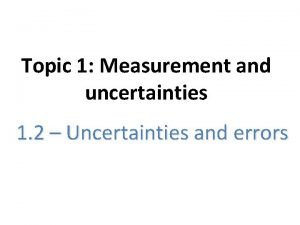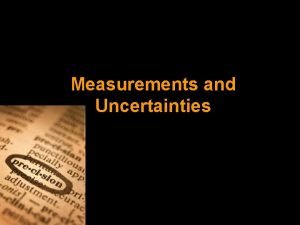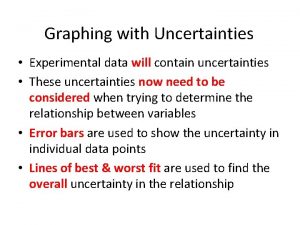Uncertainties in AMS mass concentrations Especially an important









- Slides: 9

Uncertainties in AMS mass concentrations Especially an important consideration when presenting AMS data to those outside the users’ community! Roya Bahreini AMS Clinic 2012

Calculating mass concentrations Parameter Uncertainty IENO 3 10% Procedure Reference Routine NH 4 NO 3 cals RIEspecies Jimenez et al. , 2003; Alfarra et al. , 2004; Canagaratna et al. , 2007 NH 4+ 10% Routine NH 4 NO 3 cals SO 42 - 15% Previous lab+ computational results OA 20% Previous lab+ computational results CE 30% Previous lab+ field results Q <0. 5% Routine cals TE 10% Lens transmission Matthew et al. , 2008, Middlebrook et al. , 2012 Bahreini et al. , JGR, 2009

Error propagation John R. Taylor. (1997) An Introduction to Error Analysis: The study of uncertainties in physical measurements. (Second Edition) Sausalito, CA: University Science books.

Overall uncertainty Q, IE, CE uncertainties Q, IE, CE, TE uncertainties NH 4+ 33% 34% NO 3 - 33% 34% SO 42 - 35% 36% OA 37% 38% • Total AMS mass: Overall uncertainty of 20 -35% • Note: uncertainty in the ratios may be better since some of the parameters cancel out (for example, NH 4/SO 4 has a better uncertainty since uncertaitny in IENO 3, CE, and Q cancel out.

Accuracy (uncertainty) vs. Precision High Accuracy Low Precision Low Accuracy High Precision • Precision: • Noise in the data • detection limit

Mass Closure • Mass Ratio =(AMS mass+BC mass)/(volume×r) – – AMS mass: 30% uncertainty BC mass: 15% uncertainty Volume: 30 -45% uncertainty from UHSAS mass weighted density (r): 7% uncertainty (10% uncertainty of r. OA ) Mass Ratio: Overall uncertainty of 45%

x Mass closure: Mass Ratio 2 s circle of combined uncertainties Middlebrook et al. , AST, 2012

Aerosol Acidity Effect CEdry = max (0. 45, 1. 0 − 0. 73 ×NH 4/NH 4, predict) [Eq. 4] “Apparent CE” (AMS w/ CE=1) • Acidity , CE NH 4+, predict=18×(2×SO 42 -/96 +NO 3 -/62 +Cl-/35)

Aerosol Nitrate Effect CEdry = max(0. 45, 0. 0833 + 0. 9167×ANMF) [ Eq. 6] “Apparent CE” (AMS w/ CE=1) n ANMF , CE ANMF=80/62×NO 3 -/(SO 42 -+NO 3 -+Cl-+NH 4++OA)
 Intracellular k concentration
Intracellular k concentration Advanced higher physics uncertainties
Advanced higher physics uncertainties Uncertainty when dividing
Uncertainty when dividing Measurements and uncertainties ib physics
Measurements and uncertainties ib physics Random uncertainty
Random uncertainty From most important to least important in writing
From most important to least important in writing Inverted pyramid in news writing
Inverted pyramid in news writing Least important to most important
Least important to most important Verbal interchange of ideas especially conversation.
Verbal interchange of ideas especially conversation. Forecasting is difficult especially about the future
Forecasting is difficult especially about the future
